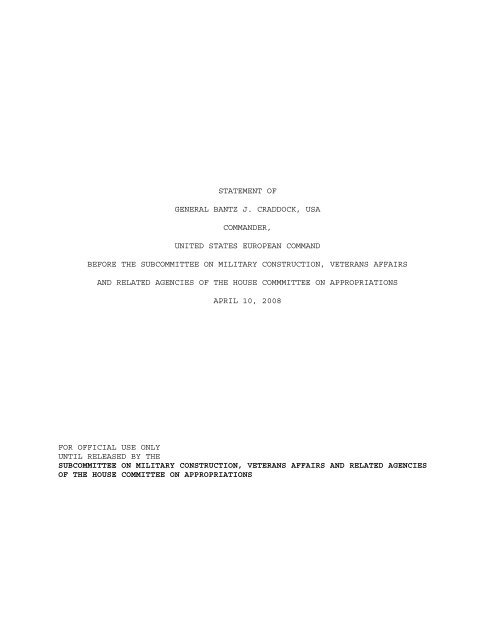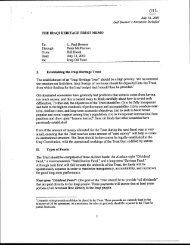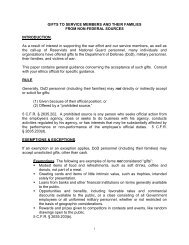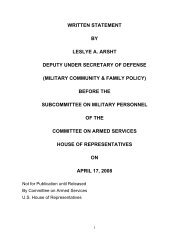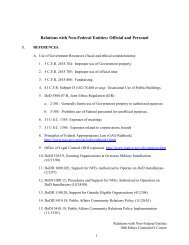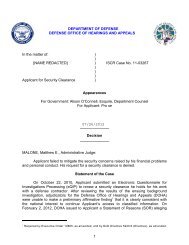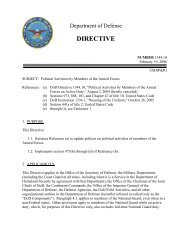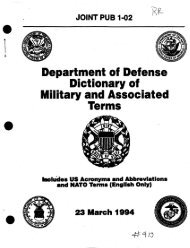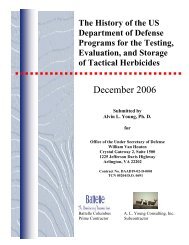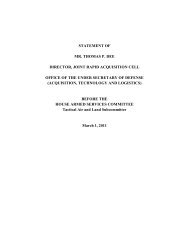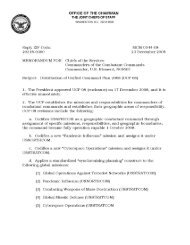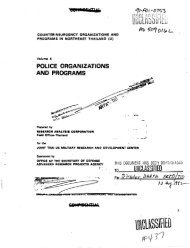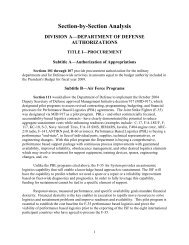07 EUCOM Posture Statement - United States Department of Defense
07 EUCOM Posture Statement - United States Department of Defense
07 EUCOM Posture Statement - United States Department of Defense
You also want an ePaper? Increase the reach of your titles
YUMPU automatically turns print PDFs into web optimized ePapers that Google loves.
STATEMENT OF<br />
GENERAL BANTZ J. CRADDOCK, USA<br />
COMMANDER,<br />
UNITED STATES EUROPEAN COMMAND<br />
BEFORE THE SUBCOMMITTEE ON MILITARY CONSTRUCTION, VETERANS AFFAIRS<br />
AND RELATED AGENCIES OF THE HOUSE COMMMITTEE ON APPROPRIATIONS<br />
APRIL 10, 2008<br />
FOR OFFICIAL USE ONLY<br />
UNTIL RELEASED BY THE<br />
SUBCOMMITTEE ON MILITARY CONSTRUCTION, VETERANS AFFAIRS AND RELATED AGENCIES<br />
OF THE HOUSE COMMITTEE ON APPROPRIATIONS
House Appropriations Subcommittee on Military Construction, Veterans’ Affairs<br />
and Other Agencies – Written <strong>Statement</strong><br />
Outline<br />
INTRODUCTION<br />
STRATEGIC ENVIRONMENT<br />
Transnational Terrorism in <strong>EUCOM</strong>’s AOR<br />
Weapons <strong>of</strong> Mass Destruction<br />
U.S. EUROPEAN COMMAND<br />
Strategic Approach<br />
Theater Objectives and Priorities<br />
The Global War on Terror<br />
Strategic En Route Infrastructure<br />
Supporting Other Combatant Commands<br />
Strategic Theater Transformation<br />
Theater Investment Needs<br />
STT and Operational Programs<br />
Quality <strong>of</strong> Life (QoL)<br />
Component Command Requirements<br />
U.S. Army, Europe<br />
U.S. Air Forces, Europe<br />
U.S. Naval Forces, Europe<br />
Marine Forces, Europe<br />
Special Operations Command, Europe<br />
Quality <strong>of</strong> Life (QOL) Programs<br />
Service Member and Family Housing<br />
<strong>Department</strong> <strong>of</strong> <strong>Defense</strong> Education Activity<br />
Force Protection<br />
Exercise Related Construction<br />
Ballistic Missile <strong>Defense</strong> (BMD)<br />
Alternative Infrastructure Funding Programs<br />
Residual Value (RV) / Payment–in-Kind (PIK)<br />
Build-to-Lease<br />
<strong>EUCOM</strong>/NATO INTERELATIONSHIP<br />
Operational Imperatives within the Alliance<br />
NATO Security Investment Program (NSIP)<br />
CONCLUSION<br />
2
INTRODUCTION<br />
<strong>United</strong> <strong>States</strong> European Command (<strong>EUCOM</strong>) Area <strong>of</strong> Responsibility (AOR)<br />
currently comprises 93 diverse nations in Europe, Eurasia, and most <strong>of</strong><br />
Africa. The forward defense <strong>of</strong> the <strong>United</strong> <strong>States</strong> largely depends on our<br />
ability to work with partners and allies to ensure common security. <strong>EUCOM</strong>’s<br />
Strategy <strong>of</strong> Active Security supports the national defense strategy through a<br />
series <strong>of</strong> broad cooperative and engagement initiatives.<br />
<strong>EUCOM</strong>’s mission is to defend the homeland forward and support U.S.<br />
strategic and economic interests by maintaining ready forces for full<br />
spectrum operations, securing strategic access and global freedom <strong>of</strong> action,<br />
enhancing trans-Atlantic security through NATO, and promoting regional<br />
stability. While support to the Global War on Terror (GWOT) is our<br />
overarching priority, <strong>EUCOM</strong> is dedicated to retaining Europe and Eurasia as<br />
global partners and furthering the U.S. security relationship with Africa<br />
through a new unified command (U.S. Africa Command or AFRICOM). Embedded in<br />
these strategic priorities are our efforts to transform ourselves into a more<br />
expeditionary command, while cultivating and sustaining relations with<br />
numerous regional security organizations, such as the North Atlantic Treaty<br />
Organization (NATO), the Organization for Security and Cooperation in Europe<br />
(OSCE), and the African Union (AU)<br />
In addition to my role as Commander <strong>EUCOM</strong>, I have responsibilities as<br />
the Supreme Allied Commander, Europe (SACEUR), commanding all operational<br />
NATO forces. While these two roles have distinct mandates, there are many<br />
linkages between them. One fundamental linkage is transformation: both<br />
<strong>EUCOM</strong>’s and NATO’s transformation efforts are aggressive, ambitious, and<br />
geared toward realizing agile, flexible, and expeditionary forces capable <strong>of</strong><br />
operating at strategic distances.<br />
The realization <strong>of</strong> the strategic priorities <strong>of</strong> the <strong>United</strong> <strong>States</strong>, as<br />
well as the transformation <strong>of</strong> both <strong>EUCOM</strong> and NATO, depend in part on the<br />
ability to live on, train in, and operate from bases, operating sites, and<br />
security locations around the <strong>EUCOM</strong> AOR. The transformation <strong>of</strong> forces and<br />
repositioning <strong>of</strong> infrastructure locations will be fundamental to ensuring our<br />
ability to meet the challenges <strong>of</strong> an ever changing security landscape. To<br />
fully capture how <strong>EUCOM</strong> will address its priorities, I will provide an<br />
overview <strong>of</strong> the infrastructure requirements <strong>of</strong> my theater and how these<br />
requirements help achieve our theater strategy.<br />
3
STRATEGIC ENVIRONMENT<br />
Today, the <strong>EUCOM</strong> Area <strong>of</strong> Responsibility (AOR) includes Europe,<br />
Russia, the Caucasus, most <strong>of</strong> Africa, Greenland, Antarctica and the waters<br />
within these borders (Enclosure 1). Composed <strong>of</strong> 93 sovereign nations, the<br />
AOR is home to approximately 1.4 billion people, 23 percent <strong>of</strong> the world’s<br />
population. Their 1,000 plus ethnic groups speak more than 400 languages,<br />
pr<strong>of</strong>ess over 100 religious affiliations, experience the full range <strong>of</strong> human<br />
conditions, and live under a variety <strong>of</strong> systems <strong>of</strong> government. The trends<br />
and issues which define the current environment in our theater include<br />
terrorism in multiple forms, frozen conflicts, unresolved territorial<br />
disputes, complex geopolitical relationships between Russia and the nations<br />
<strong>of</strong> the former Soviet Union, the use <strong>of</strong> energy as a tool <strong>of</strong> foreign policy,<br />
Weapons <strong>of</strong> Mass Destruction (WMD), criminality, and illegal immigration.<br />
The <strong>United</strong> <strong>States</strong> presence in Europe continues to make strategic sense.<br />
Europe is home to some <strong>of</strong> our oldest and closest allies. For six decades its<br />
mature democracies have experienced an unprecedented period <strong>of</strong> security and<br />
stability. A major source <strong>of</strong> this stability has been the NATO Alliance and<br />
other multinational institutions that have successfully addressed numerous<br />
security challenges over the past almost 60 years. NATO remains Europe’s<br />
premier security organization and the international security instrument <strong>of</strong><br />
choice. However, not all trends are positive. The defense budgets <strong>of</strong> many<br />
<strong>of</strong> these NATO nations have fallen to a level that jeopardizes their ability<br />
to meet long-term strategic military commitments critical to the Alliance’s<br />
21 st Century ambitions.<br />
Many persistent challenges remain throughout the <strong>EUCOM</strong> AOR. While<br />
political and military situations are improving in southeastern Europe, there<br />
are unresolved issues which could destabilize the region. The Balkans remain<br />
somewhat volatile as new democratic governments attempt to deal with<br />
suppressed ethnic tensions, corruption, illegal immigration, and assimilation<br />
<strong>of</strong> citizens from different cultural backgrounds. Kosovo, due to its<br />
controversial nature, continues to be a source <strong>of</strong> instability in the greater<br />
Balkans region. After 8 years as a UN-administered Serbian province, Kosovo<br />
declared independence on 17 Feb 2008. The U.S. Government recognized Kosovo<br />
as a sovereign state along with France, Germany and the UK. Currently, 36<br />
nations have recognized Kosovo and the US is encouraging all 27 members <strong>of</strong><br />
the EU to unite in recognizing Kosovo. <strong>EUCOM</strong> expects political and<br />
4
diplomatic efforts to continue throughout 2008 as Kosovo prepares to adopt<br />
and implement the tenets <strong>of</strong> the Ahtisaari recommendations. A secular<br />
democracy with a Muslim population, Turkey is a globally relevant example <strong>of</strong><br />
the successful integration <strong>of</strong> these two elements. It is also geographically,<br />
economically, politically, and militarily critical. Turkey’s geostrategic<br />
location, European orientation, and enduring relationship with the <strong>United</strong><br />
<strong>States</strong> make it a bridge <strong>of</strong> stability between the Euro-Atlantic community and<br />
the nations <strong>of</strong> Central Asia and the Persian Gulf. Its international lines <strong>of</strong><br />
communication are an important factor in energy security. Its proximity to<br />
Iran, Iraq, Syria and Russia ensure Turkey will continue to play a vital role<br />
in international efforts to combat terrorism.<br />
On the continent <strong>of</strong> Africa, we face a complex environment with enormous<br />
challenge and potential. To meet that challenge, <strong>EUCOM</strong> is supporting<br />
AFRICOM, currently a sub-unified command subordinate to <strong>EUCOM</strong> expected to<br />
reach Full Operational Capability (FOC) by 30 September 2008.<br />
Transnational Terrorism in <strong>EUCOM</strong>’s AOR<br />
Like all combatant commands, <strong>EUCOM</strong> is dealing with terrorism in all its<br />
forms. Many terror networks are integrally tied to criminal and smuggling<br />
networks. Illegal activities such as drug smuggling, document forgery and<br />
credit card fraud help fund extremist operations while Europe's open borders<br />
facilitate travel across the region.<br />
In northern Africa, Al-Qa’ida affiliated groups exploit ungoverned<br />
spaces to gain sanctuary needed to recruit, indoctrinate, train, equip,<br />
transit, and mount operations. The Trans-Sahara region, in particular,<br />
<strong>of</strong>fers sanctuary to Islamic extremist terrorists, smugglers <strong>of</strong> drugs and<br />
contraband, and insurgent groups. There is increasing evidence <strong>of</strong> North<br />
Africans being recruited as foreign fighters in Iraq; in addition, we are<br />
seeing increasing collaboration between Al-Qa’ida and North African terrorist<br />
groups. These negative developments are occurring despite host nation<br />
security efforts. In this region, violent extremists continue to coordinate<br />
activities and interact with associated networks in Europe. These groups<br />
take advantage <strong>of</strong> vast ungoverned spaces to attack host governments and<br />
advance extremist, anti-Western agendas.<br />
Western Europe, southeast Europe, and Eurasia continue to be used as<br />
extremist sanctuaries and logistics centers. Due to extremists’ exploitation<br />
<strong>of</strong> well established civil liberties and capacity to travel freely across many<br />
5
orders, Europe’s ability to identify, arrest, and prosecute transnational<br />
terrorists is an important element <strong>of</strong> the GWOT.<br />
Another key characteristic <strong>of</strong> terrorism in the <strong>EUCOM</strong> AOR relates to the<br />
low-risk/high-consequence aspect <strong>of</strong> the potential use <strong>of</strong> WMD. With the<br />
majority <strong>of</strong> the world’s nuclear weapons in the <strong>EUCOM</strong> AOR, the loss <strong>of</strong> control<br />
<strong>of</strong> any weapon or associated material could lead to catastrophic results,<br />
making the security <strong>of</strong> these items a significant aspect <strong>of</strong> the <strong>EUCOM</strong> WMD<br />
effort.<br />
Weapons <strong>of</strong> Mass Destruction<br />
The acquisition and potential employment <strong>of</strong> Weapons <strong>of</strong> Mass Destruction<br />
by state and non-state actors pose a security threat to the <strong>United</strong> <strong>States</strong> and<br />
our partners and Allies. The majority <strong>of</strong> the world’s nuclear weapons are<br />
located within the <strong>EUCOM</strong> AOR. Furthermore, in Europe and Eurasia, stockpiles<br />
may become vulnerable to access and removal by international and internal<br />
threats as state and non-state actors continue to improve their capabilities,<br />
or via corruption, criminal activity, and inadequate border monitoring.<br />
Coordination between our nonproliferation and counterproliferation efforts is<br />
increasingly important.<br />
Preventing the proliferation <strong>of</strong> WMD delivery systems, in<br />
particular ballistic missiles, is a key component <strong>of</strong> our efforts to<br />
prevent WMD proliferation. On the periphery <strong>of</strong> the <strong>EUCOM</strong>’s AOR, Iran’s<br />
continued ballistic missile development program poses a potential future risk<br />
to U.S., NATO, and partner interests. Iran already possesses ballistic<br />
missiles that can reach parts <strong>of</strong> Europe and is developing a new Intermediate<br />
Range Ballistic Missile (IRBM) which could reach most <strong>of</strong> Europe. In the<br />
coming decade, Iran may also have an Inter-Continental Ballistic Missile<br />
(ICBM) capable <strong>of</strong> reaching all <strong>of</strong> Europe and parts <strong>of</strong> the U.S.<br />
U.S. EUROPEAN COMMAND<br />
The <strong>EUCOM</strong> Strategy <strong>of</strong> Active Security is based upon two overarching<br />
Strategic Objectives: “Defend the Homeland” and “Create and Maintain an<br />
Environment that Advances U.S. Strategic and Economic Interests.” Our<br />
objectives include promoting lasting security and stability, maintaining the<br />
ability to employ the full range <strong>of</strong> capabilities across the military<br />
spectrum, and fostering the growth <strong>of</strong> good governance, strong institutions,<br />
and civil society.<br />
6
Strategic Approach<br />
<strong>EUCOM</strong>’s strategy looks out five years, focusing on proactive security<br />
cooperation activities while maintaining a high state <strong>of</strong> military readiness.<br />
Our strategic approach promotes stable environments, protects U.S. interests,<br />
and reduces the likelihood <strong>of</strong> crises that trigger contingency responses by:<br />
mitigating risk while the nation is at war; maintaining and strengthening<br />
alliances, partnerships, influence, and access where we have long-standing<br />
relationships; and, creating and expanding influence into new areas <strong>of</strong> the<br />
theater.<br />
Theater Objectives and Priorities<br />
Our strategy identifies a number <strong>of</strong> Theater Objectives that provide<br />
focus and purpose for <strong>EUCOM</strong>’s activities and align us with the larger<br />
Strategic Objectives. These objectives include: ensuring <strong>EUCOM</strong> forces are<br />
trained and ready for global deployment; actively working with Europe as a<br />
security partner in order to solve common problems; transforming <strong>EUCOM</strong> and<br />
NATO militaries to ensure effective expeditionary capabilities for the<br />
conduct <strong>of</strong> out-<strong>of</strong>-area operations; building partner nation capacity necessary<br />
for the provision <strong>of</strong> their own security and the sustainment <strong>of</strong> regional<br />
stability; protecting Allies and partners within a stable Middle East;<br />
preserving basing and access to ensure strategic freedom <strong>of</strong> action; averting<br />
local crises and preventing those that do arise from becoming regional<br />
conflicts.<br />
In the near term we are focusing our activities and resources on the<br />
following strategic priorities:<br />
• Support for Operations IRAQI, ENDURING FREEDOM, and NATO International<br />
Stabilization Force (ISAF)<br />
• Maintain relevance <strong>of</strong>, and U.S. leadership within, NATO<br />
• Increase integration <strong>of</strong> <strong>EUCOM</strong> activities with the rest <strong>of</strong> the U.S.<br />
Government; especially combating terrorism and WMD proliferation<br />
• Engage Russia or mitigate the impact <strong>of</strong> confrontational Russian<br />
policies<br />
7
• Support improved energy security for Europe, Eurasia, and the Black Sea<br />
region, to include NATO and <strong>EUCOM</strong><br />
• Ensure the successful transition <strong>of</strong> AFRICOM from a sub-unified command<br />
to a fully-operational Combatant Command<br />
• Support NATO transformation for out-<strong>of</strong>-area operations<br />
• Focus <strong>EUCOM</strong> transformation to ensure <strong>EUCOM</strong> has the capabilities to<br />
conduct both security cooperation activities and wartime missions<br />
The Global War on Terror<br />
<strong>EUCOM</strong>’s number one theater-wide goal remains the defeat <strong>of</strong><br />
transnational extremist organizations that threaten the <strong>United</strong> <strong>States</strong>, its<br />
Allies, and interests. We seek to do this by denying them freedom <strong>of</strong> action<br />
and access to resources, building partner capacity to combat terrorism, and<br />
working with partners to promote regional stability and diminish the<br />
conditions that foster violent extremism.<br />
We will continue our work to deter, interdict, or defeat violent<br />
extremism wherever it appears. These efforts involve close cooperation with<br />
U.S. Central Command (CENTCOM), U.S. Special Operations Command (SOCOM), U.S.<br />
Government agencies and departments, and perhaps most importantly, a growing<br />
list <strong>of</strong> foreign government partners with the same desire to protect their<br />
societies from the threat <strong>of</strong> terrorism.<br />
<strong>EUCOM</strong>-stationed forces continue to be heavily engaged in ongoing combat<br />
operations in Iraq and Afghanistan as well as in building partner nation and<br />
coalition capacity supporting these operations. Over 70 percent <strong>of</strong> our<br />
Coalition partners in Iraq and Afghanistan come from the <strong>EUCOM</strong> AOR.<br />
Outside <strong>of</strong> direct support to combat operations, <strong>EUCOM</strong>-based forces are<br />
in the forefront <strong>of</strong> promoting the transformation <strong>of</strong> militaries in our area <strong>of</strong><br />
operation. The engagement with, and support to, our Allies and partners<br />
underlines the importance <strong>of</strong> persistent presence <strong>of</strong> U.S. forces for building<br />
effective expeditionary capacity for multilateral theater and global<br />
operations.<br />
Strategic En Route Infrastructure<br />
<strong>EUCOM</strong>’s experience in the GWOT demonstrates the value <strong>of</strong> a robust<br />
European infrastructure. Our network has evolved given the fact that the<br />
8
GWOT dictates fighting the enemy in places unforeseen before 9-11. The U.S.<br />
Transportation Command (TRANSCOM) relies on six key European bases – Main<br />
Operating Bases (MOBs) Ramstein and Spangdahlem, Germany; Mildenhall, U.K.;<br />
and Rota, Spain; and Forward Operating Sites (FOSs) in Moron, Spain; and<br />
Fairford, U.K. – to project U.S. forces to crisis areas in the Middle East,<br />
Africa, eastern Europe, and the Caucasus. Continued investment in these six<br />
strategically located facilities will ensure we maintain critical air<br />
mobility routes for U.S. forces and an “air-bridge” to expand operational<br />
reach.<br />
In the near term, <strong>EUCOM</strong> is actively addressing emerging requirements to<br />
the South and East, including en-route expansion possibilities and locations,<br />
new air and sea port uses, and continued support to AFRICOM. <strong>EUCOM</strong>’s<br />
infrastructure is evaluated through the TRANSCOM Global En-Route<br />
Infrastructure Steering Committee and the Installation Planning Review Board<br />
in order to shape <strong>EUCOM</strong>'s strategy and funding requirements. From FY06 to<br />
FY08, <strong>EUCOM</strong> has received $70.6M in MILCON for five <strong>EUCOM</strong> en-route<br />
infrastructure projects. Additionally, the NATO Security Investment Program<br />
provides cost recoupment opportunities for <strong>EUCOM</strong> while increasing the<br />
capabilities <strong>of</strong> the Alliance.<br />
Future <strong>EUCOM</strong> en-route infrastructure requirements will continue to be<br />
shaped by emerging global access demands from changes in the long-term <strong>EUCOM</strong><br />
force posture, seam regions such as the Caucuses and Central Asia, transregional<br />
mobility support to CENTCOM, transition planning for AFRICOM, and<br />
NATO/ISAF operations.<br />
Supporting Other Combatant Commands<br />
<strong>EUCOM</strong>’s Strategic Theater footprint continues to provide key support to<br />
CENTCOM for OIF/OEF. In addition to the critical logistics throughput <strong>of</strong><br />
forces and material provided by the six mobility hubs mentioned above, <strong>EUCOM</strong><br />
also provides basing for Intelligence, Surveillance, and Reconnaissance (ISR)<br />
assets flying sorties in support <strong>of</strong> CENTCOM operations. Future <strong>EUCOM</strong> ISR<br />
basing plans will leverage new platforms by providing increased support to<br />
<strong>EUCOM</strong>, AFRICOM and CENTCOM ISR requirements to satisfy global ISR<br />
initiatives.<br />
<strong>EUCOM</strong> has provided CENTCOM critical support with prepositioned<br />
equipment. Army Pre-positioned Equipment Sets (APS) afloat as well as Marine<br />
Corps’ Maritime Pre-positioning Squadron ONE (MPSRON 1) have deployed from<br />
<strong>EUCOM</strong> to Diego Garcia to better support U.S. Pacific Command (PACOM)<br />
9
humanitarian assistance and CENTCOM combat and humanitarian assistance<br />
operations.<br />
<strong>EUCOM</strong> MOBs continue to support CENTCOM with essential medical support.<br />
Landstuhl Medical Facility in Germany remains the primary facility for<br />
OIF/OEF/ISAF (US) casualty treatment accepting all cases for treatment and<br />
convalescence before these service members are sent back to the continental<br />
U.S. (CONUS).<br />
Brigades stationed in Europe routinely support the Global Force<br />
Management Process (GFMP) with forces deploying for multiple rotations to<br />
OIF, OEF and ISAF from bases in Germany and Italy.<br />
The establishment <strong>of</strong> AFRICOM represents a new DoD strategy for the<br />
continent. This new approach relies on using security cooperation and<br />
leveraging multinational partnerships to build African security capacity.<br />
In carrying out its missions, AFRICOM will consolidate the efforts <strong>of</strong><br />
three commands into a single command focused solely on Africa (with the<br />
exception <strong>of</strong> Egypt, which will remain in CENTCOM’s AOR, but will be a country<br />
<strong>of</strong> mutual interest with AFRICOM). Countries within the AFRICOM AOR align with<br />
those in the African Union (AU) and this synchronization <strong>of</strong> states, under one<br />
Command, will facilitate cooperation and coordination between the U.S. and<br />
the AU, partner countries, and allies. <strong>EUCOM</strong> has provided, and will continue<br />
to make available, personnel, African subject-matter expertise, and<br />
resources, all <strong>of</strong> which will help ensure AFRICOM’s future success in becoming<br />
a self-sufficient Unified Combatant Command.<br />
Strategic Theater Transformation<br />
Our forward-based and rotational forces are powerful and visible<br />
instruments <strong>of</strong> national influence and international commitment. Central to<br />
<strong>EUCOM</strong>’s efforts is the completion <strong>of</strong> our Strategic Theater Transformation<br />
(STT) plan. This involves a basing strategy that seeks to sustain and<br />
leverage commitments to our long-standing Allies and U.S. operations in other<br />
theaters, such as OEF and OIF.<br />
<strong>EUCOM</strong>’s STT plan, in execution since 2002, ensures operational forces<br />
and prepositioned logistics are correctly postured to meet current and<br />
potential challenges. We have consolidated forces from broadly dispersed<br />
locations to MOBs and FOSs in the UK, Germany, Italy, Spain, Portugal,<br />
Turkey, Greece, Belgium, The Netherlands, Bulgaria, and Romania. MOBs, with<br />
permanently assigned operating forces, robust infrastructure, enhanced<br />
command and control capabilities, and enduring family support facilities,<br />
10
support our down-range, smaller installations. FOSs are scalable<br />
installations, primarily intended to support rotational forces with limited<br />
permanent U.S. military presence.<br />
<strong>EUCOM</strong>’s STT plan includes retaining eight fighter aircraft squadrons in<br />
the UK, Germany, and Italy. For ground forces, it includes two permanently<br />
stationed brigade combat teams — a Stryker Brigade Combat Team in Germany and<br />
an Airborne Brigade Combat Team (ABCT) in Italy. <strong>EUCOM</strong>’s STT is closely<br />
synchronized with OSD, the Joint Staff, individual Services, and NATO to<br />
ensure that global efforts <strong>of</strong> other Combatant Commands, NATO, and the results<br />
<strong>of</strong> the Base Closure and Realignment (BRAC) Commission process in the U.S. are<br />
mutually supportive. STT aims at improving our effectiveness and operational<br />
flexibility, but it has at the same time significantly reduced costs.<br />
Since the STT process began <strong>EUCOM</strong> has closed 43 sites and installations<br />
and returned approximately 11,000 servicemembers and 16,000 family members to<br />
the <strong>United</strong> <strong>States</strong>. Subject to developments in the geopolitical environment,<br />
current plans anticipate the closure <strong>of</strong> several hundred other bases and<br />
installations, the return <strong>of</strong> over 32,000 more military personnel and over<br />
43,000 more family members to the <strong>United</strong> <strong>States</strong>, and the downsizing <strong>of</strong> 14,500<br />
DOD civilians and host nation employee positions by 2013.<br />
This new posture dramatically balances our infrastructure with our<br />
strategic flexibility and our operational reach. This will, in turn, yield a<br />
considerable increase in the level <strong>of</strong> cooperation with nations closer to<br />
areas <strong>of</strong> potential instability.<br />
Theater Investment Needs<br />
<strong>EUCOM</strong>’s strategy relies on U.S. presence to provide security and<br />
stability within governments and countries located in the AOR and to build<br />
partner nation capability. <strong>EUCOM</strong> must ensure forces are in the correct<br />
location and with the correct facilities to source theater and global needs<br />
and postured to contend with uncertainty in a continually changing strategic<br />
environment. The <strong>EUCOM</strong> Master Plan documents a strategic distribution <strong>of</strong><br />
MOBs, FOSs, and Cooperative Security Locations (CSLs), which provide power<br />
projection, force sustainment, force protection, and in-country leadership<br />
opportunities that support the STT Plan throughout the AOR.<br />
Our basing strategy seeks to sustain and leverage our commitments to our<br />
long-standing NATO allies. We maintain a presence in Western Europe, making<br />
necessary improvements to enduring bases and training facilities critical for<br />
the accomplishment <strong>of</strong> our missions, while at the same time shifting our focus<br />
11
to improve the ability <strong>of</strong> new allies and partners to rapidly deploy and<br />
operate with our forces. The goals <strong>of</strong> this strategy are to deepen and<br />
strengthen relations with our newer allies; develop our focus to the south<br />
and east <strong>of</strong> our theater; maintain our national commitment to NATO; and<br />
improve interoperability with like-minded friends, allies, and major nongovernmental<br />
organizations.<br />
<strong>EUCOM</strong>’s ability to transform and achieve U.S. national security<br />
objectives depends on the investment provided for military construction. We<br />
are investing MILCON resources in enduring installations.<br />
The FY09 President’s Budget requests a total <strong>of</strong> $783.3M in MILCON funds<br />
for <strong>EUCOM</strong> (Enclosure 2). This investment will enable us to continue to<br />
eliminate substandard housing, includes projects that will pay dividends as<br />
we divest non-enduring bases and consolidate our forces into more efficient<br />
communities and provide defenses against ballistic missile threats from<br />
Southwest Asia.<br />
STT and Operational Programs<br />
The FY09 MILCON request includes $492.3M for six significant STT and<br />
operational programs:<br />
- $119.0M for the 7th Army Theater Command and Control Facility at<br />
Wiesbaden, Germany, beginning the consolidation <strong>of</strong> 7 th Army command and<br />
control capability and eliminating split-based operations (signal assets<br />
in Mannheim, intelligence capability in Darmstadt and Army headquarters<br />
in Heidelberg);<br />
- $19.0M for operational facilities supporting the Shadow Unmanned Aerial<br />
System (UAS) operations in the Grafenwoehr/Vilseck MOB;<br />
- $30.0M <strong>of</strong> the $173M required ($46M was funded in FY08) for completion <strong>of</strong><br />
Army infrastructure at MOB Vicenza, Italy, and to consolidate the 173 rd<br />
Airborne Brigade Combat Team (ABCT), the only split-based brigade in the<br />
Army;<br />
- $48.0M for a <strong>Defense</strong> Logistics Agency funded Logistics Distribution<br />
Center, at Germersheim, Germany, to meet <strong>EUCOM</strong>’s theater cross-docking<br />
requirements and streamline the distribution operations to support<br />
current and future contingencies;<br />
- $27.8M for Fuel Storage Tanks and distribution at Souda Bay, Greece,<br />
providing additional fuel storage capacity and replacement <strong>of</strong> an existing<br />
but deteriorating JP-5 fuel line from the Marathi Depot to Naval Support<br />
Activity (NSA) Souda Bay;<br />
12
- $7.4M for construction <strong>of</strong> a fully Anti-Terrorism/Force Protection (AT/FP)<br />
compliant Large Vehicle Inspection Station at RAF Lakenheath, UK.<br />
- $132.6M for an expanded Ground-Based Mid-course <strong>Defense</strong> (GMD)<br />
system and a GMD Battle Management Fire Control and Communication<br />
(GBMFC2) In-Flight Interceptor Communications System (IFICS) Data<br />
Terminal.<br />
- $108.6M to support the European Mid-Course X-Band Radar (EMR) site,<br />
with a single operations, maintenance and storage facility, BMDS<br />
Communications Support Complex (BCSC), security and entry control<br />
facility, power plant, fuel unload & storage, and all supporting<br />
infrastructure.<br />
Quality <strong>of</strong> Life (QoL): <strong>EUCOM</strong> QOL construction investments affirm our<br />
commitment to our servicemembers and families. For FY09 our request for<br />
Family Housing renovation and replacement projects will ensure our forces are<br />
provided quality housing for their families. The significant investment in<br />
this requirement since 2003, over $1.1B to date, has demonstrated your<br />
commitment to providing adequate housing. Additionally, we continue to use<br />
Build-to-Lease (BTL) housing as a significant part <strong>of</strong> our recapitalization<br />
plan when it provides an economically viable alternative. We are requesting<br />
the following QoL projects in the FY09 MILCON submission:<br />
- $291.0M for Family Housing construction, renovation and replacement:<br />
-- $133.0M for construction <strong>of</strong> 326 housing units at Wiesbaden,<br />
Germany in support <strong>of</strong> 7th Army consolidation;<br />
-- $71.8M to construct 182 replacement housing units at<br />
Lakenheath(phase 5);<br />
-- $86.2M for renovation <strong>of</strong> 372 housing units to meet the family<br />
housing requirements at Wiesbaden, Germany; Lakenheath, U.K.; Alconbury<br />
and Menwith Hill, U.K.; and Lajes, Portugal.<br />
Component Command Requirements<br />
U.S. Army, Europe<br />
The most critical aspect <strong>of</strong> <strong>EUCOM</strong>’s transformation continues to be the<br />
realignment <strong>of</strong> forces and bases for U.S. Army, Europe (USAREUR). Significant<br />
work has been accomplished in executing our plans to date. The 2 nd Stryker<br />
Cavalry Regiment (SCR) has been successfully stationed in Vilseck, Germany;<br />
13
oth the 173 rd ABCT and the 12 th Combat Aviation Brigade have been reorganized<br />
and converted to their new standard, modular designs; and we will have<br />
returned nearly 20,000 Soldiers from Europe by the fall <strong>of</strong> 2008. These<br />
actions were all accomplished while deploying between 20 and 30 thousand<br />
Soldiers from Europe each year from 2003 to 2006 in support <strong>of</strong> OIF, OEF, and<br />
ISAF.<br />
Our FY09 military construction request builds on last year’s request by<br />
continuing our transformation progress. This request begins the critical<br />
move and consolidation <strong>of</strong> the 7 th Army Command and Control capability to<br />
Wiesbaden, Germany. It also adds to our capability at the Grafenwoehr<br />
training area by including facilities to enable operations <strong>of</strong> an Unmanned<br />
Aerial System (UAS). In addition, FY09 funding will continue the<br />
Congressionally directed incremental funding <strong>of</strong> the infrastructure investment<br />
at Dal Molin in Vicenza, Italy to consolidate the 173 rd ABCT.<br />
Future efforts will focus on continuing the consolidation <strong>of</strong> 7 th Army<br />
command and control with critical signal and intelligence assets. After<br />
completion <strong>of</strong> those consolidations, we will finish barracks upgrades,<br />
consolidate unit operational facilities, and continue to improve quality <strong>of</strong><br />
life facilities at our enduring MOBs.<br />
7 th Army Command and Control: In 2009, USAREUR and V Corps will combine to<br />
form 7 th Army which will be stationed in Heidelberg until construction <strong>of</strong> 7 th<br />
Army Theater C2 facilities are completed at Wiesbaden. The completion <strong>of</strong> the<br />
7 th Army C2 facility programmed for $119M in FY09 will enable the relocation<br />
<strong>of</strong> 7 th Army to Wiesbaden and provide a strategic/operational capability for<br />
command and control <strong>of</strong> land forces. USAREUR future MILCON remains focused on<br />
Wiesbaden with plans for a Consolidated Intelligence Center (CIC) and a<br />
Network Warfare Center.<br />
Grafenwoehr UAS: The $19M Unmanned Aerial System operational facilities<br />
support consolidation and regular training <strong>of</strong> Shadow UAS teams on our largest<br />
MOB, allowing combined arms training with the units these systems support.<br />
173 rd Airborne Brigade Combat Team (ABCT): Stationing forces in Italy<br />
demonstrates U.S. commitment to European security and positions them on the<br />
southern flank <strong>of</strong> NATO, postured south <strong>of</strong> the Alps for security cooperation<br />
or intervention in regions south and east with emerging threats. The 173 rd<br />
ABCT expanded into a full modular ABCT in 2006. This conversion doubled the<br />
14
size <strong>of</strong> the brigade, providing a greater capability for rapid deployment and<br />
forced entry operations and enhancing the brigade’s ability to sustain itself<br />
during coalition and joint operations.<br />
Germersheim Army Depot (GAD): The DLA Distribution Center project for $48M<br />
in FY09 is the lynchpin to make GAD a state <strong>of</strong> the art warehousing and<br />
distribution site with consolidated theater distribution operations for <strong>EUCOM</strong><br />
and, as needed, CENTCOM areas <strong>of</strong> responsibility. The 250,000 square foot<br />
facility will expand warehousing and distribution capacity at GAD, enabling<br />
<strong>EUCOM</strong> to develop synergies among diverse DOD distribution systems in theater.<br />
U.S. Air Forces in Europe<br />
U.S. Air Forces in Europe (USAFE) continues its evolving transformation<br />
with a force structure capable <strong>of</strong> conducting both day-to-day and contingency<br />
operations. USAFE has oriented its forces to increase responsiveness and<br />
enhance force projection as it meets the challenge <strong>of</strong> an evolving strategic<br />
environment.<br />
Large Vehicle Inspection Facility (LVIS). USAFE requires continued investment<br />
in facilities to support AT/FP requirements. This inspection facility will<br />
meet a critical requirement, one <strong>of</strong> the five most unsafe USAFE Entry Control<br />
Points, and alleviate a significant traffic choke point.<br />
U.S. Naval Forces Europe<br />
The infrastructure at U.S. Naval Forces Europe (NAVEUR) bases sustains<br />
the combat readiness <strong>of</strong> permanent, rotational and surge naval forces, as well<br />
as that <strong>of</strong> other service component forces transiting, temporarily assigned,<br />
or permanently stationed at NAVEUR bases. NAVEUR transformation, in support<br />
<strong>of</strong> the Integrated Global Presence and Basing Strategy (IGPBS), has reshaped<br />
the Navy’s footprint in Europe to support operations south and east into<br />
Africa and Eastern Europe. To this end, the bases at Keflavik, Iceland; La<br />
Maddalena, Italy and London, England have closed and NAVEUR has been under a<br />
MILCON pause. Enduring bases at Rota, Spain; Sigonella, Italy; and Souda<br />
Bay, Greece are strategically located across the Mediterranean to provide<br />
flexible and highly capable inter- and intra-theater logistic support. The<br />
base at Naples, Italy provides a consolidated command and control location<br />
for Headquarters, NAVEUR and SIXTH Fleet collocated with the NATO operational<br />
15
Headquarters <strong>of</strong> Allied Joint Forces Command Naples and Striking and Support<br />
Forces NATO.<br />
From an infrastructure perspective, NAVEUR transformation and<br />
associated base closures are substantially complete. Therefore, NAVEUR<br />
intends to end the MILCON pause that has been in effect during<br />
Transformation. Subsequent NAVEUR MILCON request will focus on targeted<br />
investment in facilities that directly support the operations and readiness<br />
<strong>of</strong> the <strong>EUCOM</strong>, CNE, Sixth Fleet and the Navy Warfare Enterprises that support<br />
them. This enables NAVEUR to maximize the impact <strong>of</strong> facilities support for<br />
specific recapitalization priorities such as critical infrastructure and<br />
systems or emergent Long War operational requirements such as the Navy’s<br />
Expeditionary Combat mission.<br />
U.S. Marine Corps Forces, Europe<br />
Headquarters, U.S. Marine Corps Forces, Europe (HQ MARFOREUR) is a two<br />
star command consisting <strong>of</strong> a small headquarters staff, numbering<br />
approximately 110 total personnel, with no assigned forces. The Marine<br />
service component is a tenant command on a US Army installation and has no<br />
bases, facilities or installations for which it is responsible. However, as a<br />
tenant, MARFOREUR funds, through Service channels, the rehabilitation and<br />
upgrade <strong>of</strong> building infrastructures which support evolving component or<br />
mandated security requirements. Through existing Inter Service Support<br />
Agreements, USAREUR and the Army’s Installation Management Command program<br />
tenant MILCON requirements which exceed the existing infrastructure capacity<br />
to include required modernization, replacement, expansion or restoration <strong>of</strong><br />
real property.<br />
The US Marine Corps is fully committed in supporting <strong>EUCOM</strong>'s strategic<br />
theater transformation by implementation <strong>of</strong> the Marine Corps Long War<br />
Concept, establishing expeditionary rotational forces available to support<br />
<strong>EUCOM</strong>'s long term strategic goals, as well as, through the support <strong>of</strong> both a<br />
new Geographic Combatant Commander and Component Commander. These initiatives<br />
will create the need for increased infrastructure requirements which exceed<br />
current capacities in order to support the headquarters and support<br />
facilities.<br />
Special Operations Command Europe<br />
Special Operations Command Europe (SOCEUR) plans, coordinates and<br />
conducts special operations to achieve US and NATO objectives as tasked by<br />
16
Commander (COM), <strong>EUCOM</strong>. COMSOCEUR applies special operations capabilities to<br />
strengthen NATO and other alliances, expand the number <strong>of</strong> security partners<br />
and improve their counterterrorist capabilities, and transform <strong>EUCOM</strong> Special<br />
Operations Forces (SOF) to defeat terrorist networks and create an environment<br />
universally hostile for terrorist extremists. There are currently no<br />
programmed MILCON requirements in direct support <strong>of</strong> SOCEUR activities,<br />
however, with Special Operations Command Africa pending stand-up also in<br />
Stuttgart, an analysis is underway to determine if some common Title 10 and<br />
SOF-unique support functions and functional areas should be consolidated.<br />
Quality <strong>of</strong> Life (QOL) Programs<br />
Taking care <strong>of</strong> <strong>EUCOM</strong>’s most precious resource, our people, is<br />
fundamental to the character <strong>of</strong> the American Armed Forces and a key combat<br />
multiplier that positively affects our warfighting effectiveness. The GWOT<br />
has called for significant sacrifices on the part <strong>of</strong> our servicemembers and<br />
places a tremendous burden on their families. As we transform our defense<br />
posture in Europe, our military communities must continue to be able to<br />
provide predictability and capacity to meet the needs <strong>of</strong> our Soldiers,<br />
Sailors, Airmen, Marines, civilians, and their families.<br />
<strong>EUCOM</strong>’s top QOL infrastructure issues are: service member and family<br />
housing and improving the quality <strong>of</strong> <strong>Department</strong> <strong>of</strong> <strong>Defense</strong> Education Activity<br />
(DoDEA) schools.<br />
Service Member and Family Housing<br />
The nine Family Housing renovation and replacement projects programmed<br />
will ensure that our forces have quality housing. <strong>EUCOM</strong>’s FY09 MILCON<br />
request includes funding for Family Housing renovation and replacement in<br />
Germany, the <strong>United</strong> Kingdom and Portugal. USAREUR is requesting MILCON funds<br />
to construct 326 new family housing units and revitalize 99 at MOB Wiesbaden,<br />
Germany. These housing projects not only help eliminate inadequate housing<br />
they also support consolidation <strong>of</strong> the 7 th Army Headquarters. USAFE is<br />
requesting new construction and renovation <strong>of</strong> 453 units to meet the family<br />
housing requirements at Alconbury, Menwith Hill and Lakenheath, <strong>United</strong><br />
Kingdom; and Lajes, Portugal. <strong>EUCOM</strong> Family Housing is on target to meet<br />
<strong>Defense</strong> Planning Guidance Standards by the 2009 programming deadline.<br />
17
<strong>Department</strong> <strong>of</strong> <strong>Defense</strong> Education Activity<br />
<strong>EUCOM</strong> works with DoDEA and DoDDS-E to provide our children with quality<br />
educational opportunities. Ensuring DoDDS-E delivers a first class education<br />
is essential to <strong>EUCOM</strong> families, whose overseas location lacks the <strong>of</strong>f-base<br />
schooling options found in the U.S. DoDDS-E has 90 schools serving <strong>EUCOM</strong>’s<br />
36,500 students. These schools represent almost half <strong>of</strong> DoDEA’s inventory <strong>of</strong><br />
199 schools, and operating and maintaining them requires constant attention<br />
and resources.<br />
Delivery <strong>of</strong> a quality education depends on good facilities. This means<br />
DoDDS-E must modernize the aging schools in Europe. Some DoDDS-E schools are<br />
in facilities constructed prior to World War II.<br />
With 45 percent <strong>of</strong> DoDEA’s schools and 43 percent <strong>of</strong> DoDEA’s students<br />
in the <strong>EUCOM</strong> theater, the health <strong>of</strong> the DoDEA budget is essential to the well<br />
being <strong>of</strong> our educational infrastructure in Europe. While <strong>EUCOM</strong> has benefited<br />
from DoDEA MILCON funding across the Five Year <strong>Defense</strong> Program (FYDP), it<br />
still has over $191M in critical MILCON school requirements for Army and Air<br />
Force installations in Europe. The projected annual DoDEA MILCON funding is<br />
inadequate to meet <strong>EUCOM</strong> school requirements. Adding to this difficult<br />
infrastructure challenge is DoDEA’s inability to provide adequate SRM funds<br />
to maintain existing aging facilities. The inevitable outcome <strong>of</strong> this<br />
situation is being played out in Europe, where our children are cramped in<br />
long-standing temporary buildings, unable to clean up after physical<br />
education, rushing through multiple-stage lunch periods, etc. Keeping in<br />
mind there are virtually zero <strong>of</strong>f-base schooling options, we strongly support<br />
an increase to DoDEA’s MILCON funding to help meet <strong>EUCOM</strong>’s requirements.<br />
<strong>EUCOM</strong> appreciates continued Congressional support to make school<br />
construction a top quality <strong>of</strong> life priority for overseas families. Giving<br />
students and their families an education comparable to what they would find<br />
stateside will mean improved recruiting and retention.<br />
Force Protection<br />
<strong>EUCOM</strong> continues its efforts to ensure we are harder to target, better<br />
protected, and more capable <strong>of</strong> responding to any terrorist attack against our<br />
personnel and assets. Commanders at all levels, security <strong>of</strong>ficers, and the<br />
intelligence community collectively realize that the real and enduring threat<br />
18
equires us to constantly evaluate, adapt and improve our efforts against a<br />
myriad <strong>of</strong> potential adversaries and evolving threats.<br />
We have made notable progress in a number <strong>of</strong> areas. Transformational<br />
basing strategies have incorporated antiterrorism principles to avoid many<br />
types <strong>of</strong> vulnerabilities endemic to the bases we have been using since the<br />
end <strong>of</strong> World War II. Our ability to make timely, accurate, and relevant<br />
threat and vulnerability based information available to deploying forces has<br />
been greatly enhanced by information tools now resident on our classified web<br />
systems. Programs developed by <strong>EUCOM</strong> are now used throughout DoD.<br />
In the FY09 MILCON request, both the construction <strong>of</strong> the 7 th Army<br />
Theater C2 facility, in support <strong>of</strong> the 7 th Army C2 consolidation at Wiesbaden,<br />
and the LVIS at Lakenheath continue the programming <strong>of</strong> facilities that<br />
support force protection requirements. While the LVIS will eliminate one <strong>of</strong><br />
the five most unsafe gates in USAFE, the programmed consolidation at<br />
Wiesbaden reduces the USAREUR footprint by three installations and provides<br />
one installation that meets force protection requirements. This<br />
consolidation not only addresses a security concern but also reduces base<br />
operating requirements.<br />
<strong>EUCOM</strong>’s methodical and prioritized acquisition <strong>of</strong> resources, combined<br />
with the development <strong>of</strong> technology to mitigate current and anticipated future<br />
threats, continues. All current projects incorporate DoD AT/FP guidance and<br />
specifications in design and construction.<br />
Exercise Related Construction<br />
Our Exercise Related Construction (ERC) program is a valuable tool and<br />
an important element <strong>of</strong> our Theater Security Cooperation program. We urge<br />
you to fully fund the President’s $9,228,000 request for this program.<br />
The ERC program is a powerful catalyst that effectively leverages<br />
austere minor military construction funding. ERC projects target specific<br />
countries or regions to enhance their capabilities in ways that support our<br />
overall theater strategy. ERC focuses on building relationships that promote<br />
our strategic interests, providing peacetime and contingency access and<br />
infrastructure through our exercise program, and integrating allies and<br />
partners effectively into combined engineering operations that reduce demands<br />
on our overtaxed U.S. forces.<br />
<strong>EUCOM</strong> aggressively engages with the Joint Staff and Service Components<br />
in planning and programming ERC each year, with <strong>EUCOM</strong> receiving approximately<br />
one-third <strong>of</strong> the limited funds available under this DoD-wide program over the<br />
19
past 4 years. In FY08, our efforts resulted in approval <strong>of</strong> eleven projects<br />
throughout the AOR totaling $2.6M. We are currently developing our<br />
requirements for the FY09 ERC program; we anticipate a continued strong need<br />
for ERC projects throughout the AOR with specific focus in Israel, Africa,<br />
and eastern Europe.<br />
Our goal for engagement through ERC is to ensure robust regional access<br />
points and continued strong support for U.S. policies and actions in underand<br />
ungoverned regions within the AOR. Continued ERC investment ensures U.S.<br />
forces have the operational and logistics bases needed to execute the <strong>EUCOM</strong><br />
mission throughout the AOR. In short, the ERC program yields a tremendous<br />
return on a small investment.<br />
Ballistic Missile <strong>Defense</strong> (BMD)<br />
As highlighted in the strategic environment, an increasingly important<br />
aspect <strong>of</strong> <strong>EUCOM</strong>’s Strategy <strong>of</strong> Active Security is defense against threats<br />
posed by emerging ballistic missile capabilities in southwest Asia. <strong>EUCOM</strong> is<br />
working with the Joint Staff, U.S. Strategic Command, and the Missile <strong>Defense</strong><br />
Agency to help field capabilities that will counter this threat with a mix <strong>of</strong><br />
interceptors, sensors, and command and control. The right combination <strong>of</strong><br />
these systems is vital to protect U.S. interests and to send a strong signal<br />
to our partners and allies, as well as potential adversaries.<br />
<strong>EUCOM</strong> is engaged in the planning effort for the deployment <strong>of</strong> long-range<br />
Ground-Based Interceptors and supporting radars in Europe to enhance the<br />
defense <strong>of</strong> the U.S. homeland, U.S. forces stationed in Europe, partners, and<br />
allies from intercontinental and intermediate range ballistic missiles. The<br />
acquisition and planned deployment <strong>of</strong> systems to the Czech Republic and<br />
Poland will be funded through the Missile <strong>Defense</strong> Agency. The military<br />
construction funding for operational facilities is detailed in the Missile<br />
<strong>Defense</strong> Agency pages <strong>of</strong> the President's Budget Request and synopsized in<br />
enclosure 2. Future military construction requirements for support<br />
facilities and associated base operations at the proposed sites are being<br />
developed. Once clarified, this information will be submitted through<br />
appropriate channels.<br />
Alternative Infrastructure Funding Programs<br />
In addition to traditional appropriated DoD and Service construction<br />
funding, <strong>EUCOM</strong> continues to aggressively leverage every available funding<br />
source to improve our operational capability and the conditions in which our<br />
20
service members live and work. These alternative funding programs include<br />
the NATO Security Investment Program (NSIP), the Residual Value (RV) program,<br />
the Payment-in-Kind (PIK) program and Quid Pro Quo. Since 1990, these<br />
programs have generated in excess <strong>of</strong> $2.1B for construction projects<br />
throughout <strong>EUCOM</strong>’s AOR. Likewise, significant efforts by the Service<br />
Components to consolidate, privatize, and outsource – particularly in<br />
acquiring build-to-lease (BTL) housing - have reduced the requirements<br />
backlog. While these programs have supplemented our MILCON program, they<br />
cannot in and <strong>of</strong> themselves substitute for the appropriated program Congress<br />
provides. NSIP will be specifically addressed later in my <strong>EUCOM</strong>/NATO<br />
comments.<br />
Residual Value (RV) / Payment–in-Kind (PIK)/ Quid Pro Quo<br />
RV is the negotiated cash payment a host nation will compensate the U.S.<br />
for infrastructure investments or major improvements on installations<br />
returned to the host nation. RV is triggered when the U.S. takes the<br />
affirmative action <strong>of</strong> closing and returning installations to the host nation.<br />
RV is subject to negotiation between the U.S. and the host nation, and is<br />
dependent upon reuse by the host nation. On average, RV settlements take<br />
five years to complete. Since 1989, the U.S. has recouped approximately<br />
$187M in RV from host nations throughout the <strong>EUCOM</strong> AOR.<br />
<strong>EUCOM</strong> developed its PIK strategy to maximize RV settlements with Germany<br />
while minimizing the financial impact to Germany. In lieu <strong>of</strong> cash payments<br />
for RV generated for a returned installation, Germany constructs facilities<br />
for U.S. forces at U.S. installations in Germany, reducing overall U.S.<br />
investment requirements. Since 1991, Germany has executed approximately<br />
$387.5M in PIK construction for U.S. Forces.<br />
The settlement with Germany for turning over Rhein-Main Air Base in<br />
2005, resulted in Quid Pro Quo projects totaling $425 million for replacement<br />
<strong>of</strong> mission capabilities that would no longer available at Rhein-Main. This<br />
funding established replacement facilities at Ramstein and Spangdahlem Air<br />
Bases, Germany. The Rhein-Main AB settlement is an exception to the norm on<br />
the residual value that the <strong>United</strong> <strong>States</strong> can expect from host nations. The<br />
German government sought the U.S. facilities at Rhein-Main due to its clear<br />
and immediate commercial value based on ever increasing demands on Frankfurt<br />
International Airport, vice finding suitable reuse for facilities that were<br />
not specifically sought out.<br />
21
Build-to-Lease<br />
Of special note is the Build-to-Lease (BTL) Program, which provides<br />
quality family housing without the need for capital investment or land<br />
acquisition by the U.S. or the host nation. Under BTL, housing areas are<br />
owned and maintained by a contractor and leased to the U.S. Leasing provides<br />
an important advantage: If the housing units are no longer needed, the U.S.<br />
can end the contract with no ownership obligations after the initial term <strong>of</strong><br />
the lease.<br />
U.S. Air Forces, Europe has successfully used the BTL program in the<br />
past to acquire 530 housing units at MOB Aviano, Italy, and is in the process<br />
<strong>of</strong> acquiring BTL housing at MOB Lakenheath, U.K., and MOB Spangdahlem,<br />
Germany to help meet their family housing requirements. The Residenza dei<br />
Marina complex near MOB Sigonella, Italy provides 526 units <strong>of</strong> BTL family<br />
housing in support <strong>of</strong> NAVEUR housing requirements. USAREUR has already<br />
acquired and started to occupy more than half <strong>of</strong> the approximately 1,600<br />
units <strong>of</strong> BTL family housing in support <strong>of</strong> families moving to the MOB<br />
Grafenwoehr area.<br />
While the use <strong>of</strong> BTL as an alternative funding mechanism for family<br />
housing is being vigorously pursued by each <strong>of</strong> the Service components,<br />
various local conditions limit its use as the sole means for acquiring<br />
quality family housing for our service members and their families. MILCON<br />
investment is still required to completely satisfy our housing requirements.<br />
<strong>EUCOM</strong>/NATO INTERELATIONSHIP<br />
We recognize that many <strong>of</strong> the challenges in the current security<br />
environment exceed the capacity <strong>of</strong> any one nation to resolve and that today’s<br />
threats require a comprehensive approach by the international community,<br />
involving a wide spectrum <strong>of</strong> civil and military instruments. <strong>EUCOM</strong>’s efforts<br />
are coordinated and complementary with a broad range <strong>of</strong> national,<br />
international, and regional actors. Most notably, <strong>EUCOM</strong> is the focal point<br />
<strong>of</strong> the U.S. military commitment to the NATO Alliance. Across the NATO<br />
Military Command Structure, U.S. military leaders are privileged to hold key<br />
positions <strong>of</strong> influence, helping to develop the Alliance agenda and execute<br />
its operations.<br />
Operational Imperatives within the Alliance<br />
NATO’s contributions to both current and future security challenges<br />
consist <strong>of</strong> a wide range <strong>of</strong> initiatives and practical activities. While<br />
22
political consultations among nations help sustain a unity <strong>of</strong> purpose, men<br />
and women <strong>of</strong> the Alliance, plus 17 other troop contributing nations, are<br />
essentially redefining the role <strong>of</strong> the Alliance by their actions in<br />
operations across Afghanistan, the Balkans, the Mediterranean, Iraq, the<br />
Baltics, and Africa. The 60,000 NATO military forces currently deployed<br />
under my command as SACEUR are a visible and effective demonstration <strong>of</strong> its<br />
resolve to collectively meet both in and out <strong>of</strong> region security challenges.<br />
NATO Security Investment Program (NSIP)<br />
<strong>EUCOM</strong> strongly supports full funding for the President’s FY 2009<br />
request <strong>of</strong> $240,687,000 for NSIP. NSIP projects meet Alliance military<br />
requirements for a wide range <strong>of</strong> operational facilities and capabilities and<br />
it contributes to provide U.S. forces operational benefits, whether stationed<br />
in Europe or transiting to other regions. The NSIP is a common-funded<br />
program dependent on consensus decision-making among the member nations and<br />
using agreed upon financial contributions by NATO nations. The program<br />
provides for the acquisition <strong>of</strong> common-use systems and equipment; the<br />
construction, upgrade and restoration <strong>of</strong> military facilities; and other<br />
related programs and projects required to carry out the full range <strong>of</strong> NATO<br />
mission requirements including crisis response operations undertaken by NATO.<br />
The program does not fund personnel support facilities such as barracks,<br />
family housing, or gymnasiums; which are considered the responsibility <strong>of</strong><br />
individual member nations.<br />
NSIP project requirements are contained in “Capability Packages” that<br />
are developed by the military planning staffs at Allied Command<br />
Transformation and Allied Command Operations based on prioritized and<br />
accepted requirements to support Alliance war-fighting capabilities. These<br />
Capability Packages are then reviewed in detail by NATO’s military and<br />
civilian decision-makers based on guidance from member nations’ governments.<br />
<strong>EUCOM</strong> and its Service Components actively participate and collaborate with<br />
NATO to ensure that U.S. interests are synchronized with NATO intentions and<br />
that NSIP common-funding is invested to support both U.S. and NATO<br />
requirements.<br />
Two examples highlight the success <strong>of</strong> <strong>EUCOM</strong>’s engagement with NATO in<br />
gaining common-funding at U.S. installations as well as strengthening bonds<br />
between the U.S. and our NATO Allies. Since 1996, NATO has invested over<br />
$200M in NSIP funding at MOB Ramstein, Germany, the main strategic airlift<br />
hub for the U.S. in Europe as well as NATO’s northern European strategic air<br />
23
hub. Additionally, in 2005 NATO approved NSIP funding for the upgrade <strong>of</strong><br />
port facilities at MOB Rota, Spain, with a current value <strong>of</strong> approximately<br />
$152M. In both circumstances, the implementation <strong>of</strong> the projects required<br />
close coordination and support from the host nations <strong>of</strong> Germany and Spain<br />
respectively. NSIP will continue to be an integral part <strong>of</strong> <strong>EUCOM</strong>’s total<br />
infrastructure program. The U.S. has proposed MOB Rota, Spain as NATO’s<br />
southern European strategic air hub. If this proposal is accepted, NATO will<br />
fund up to $71M in airfield infrastructure upgrades. A further $19M will go<br />
towards six projects at MOB Ramstein, Germany to enhance its strategic<br />
airlift capability. The U.S. has also proposed MOB Sigonella, Italy and FOS<br />
Moron, Spain as air-to-air refueling installations to support NATO. If these<br />
proposals are accepted under the emerging air refueling capability package, a<br />
combined value <strong>of</strong> approximately $120M in infrastructure enhancements may be<br />
realized.<br />
Beyond investment in infrastructure at U.S. installations in Europe,<br />
the NSIP serves additional roles that allow the U.S. to play a major<br />
leadership role in transatlantic affairs. <strong>EUCOM</strong>’s active engagement <strong>of</strong> the<br />
NATO planning staffs and our Allies assures the U.S. <strong>of</strong> a continuing key role<br />
in shaping the collective defense posture <strong>of</strong> the Alliance. Additionally,<br />
the use <strong>of</strong> NSIP to support NATO’s “out-<strong>of</strong>-area” operations in Afghanistan and<br />
Iraq ensure that Alliance forces have the critical capabilities they require<br />
to successfully conduct operations. NSIP funding to support enlargementrelated<br />
projects is a visible sign <strong>of</strong> our commitment to expanding the<br />
alliance and the successful integration <strong>of</strong> new countries into the family <strong>of</strong><br />
western democracies.<br />
The benefits <strong>of</strong> the NSIP are clear, both for <strong>EUCOM</strong> and the U.S. We<br />
will continue to pursue this funding for every eligible project and continue<br />
to work with NATO and our Allies to ensure NATO’s collective defense<br />
capability and actualize NATO’s transformation efforts.<br />
CONCLUSION<br />
The <strong>United</strong> <strong>States</strong> European Command is fully and actively engaged in<br />
addressing the challenges <strong>of</strong> this diverse area <strong>of</strong> responsibility. Even as<br />
<strong>EUCOM</strong> supports combat operations in other theaters, it is transforming its<br />
posture to shape the evolving security landscape. The FY09 military<br />
construction program continues facility investment in theater to provide the<br />
right capabilities at the right places.<br />
While the U.S. military can help set the conditions to create a stable<br />
24
environment, it is but one part <strong>of</strong> the effort required to achieve lasting,<br />
effective solutions. New and deepened partnerships within the U.S.<br />
government and among combatant commands are required to more dynamically<br />
counter the transnational trends and issues which define our theater: threats<br />
<strong>of</strong> terrorism, frozen conflicts, unresolved territorial disputes, complex<br />
geopolitical relationships, humanitarian needs, disease, and threats posed by<br />
Weapons <strong>of</strong> Mass Destruction. Moreover, global partnerships are required to<br />
better counter the threats to our collective security. <strong>EUCOM</strong> remains<br />
committed to working with European, African and Eurasian partners in<br />
collaborative efforts that meet common security challenges. Finally, the<br />
leadership and the capabilities the U.S. contributes to the NATO Alliance<br />
will remain fundamental to preserving trans-Atlantic security, now and into<br />
the future.<br />
Today’s security environment requires operational capabilities that are<br />
more agile, expeditionary, and responsive. The implementation <strong>of</strong> <strong>EUCOM</strong>’s<br />
Strategic Theater Transformation Plan, which positions and enables forces<br />
throughout a much wider portion <strong>of</strong> Europe and Africa, increases <strong>EUCOM</strong>’s<br />
strategic effectiveness within the area <strong>of</strong> responsibility while<br />
simultaneously enhancing our ability to support other Combatant Commands.<br />
Continued investment in critical infrastructure and quality <strong>of</strong> life programs<br />
enables <strong>EUCOM</strong> to conduct operations within this vast AOR while providing<br />
vital support to the GWOT.<br />
Global posture shifts and the transformation <strong>of</strong> the U.S. military have<br />
refocused strategic positioning in the <strong>EUCOM</strong> Theater. Our efforts will<br />
culminate in a force capable <strong>of</strong> operating across the broad spectrum <strong>of</strong><br />
conflict and postured to respond to crises both in the AOR and globally. The<br />
success <strong>of</strong> our engagement hinges on ensuring the presence <strong>of</strong> relevant<br />
capabilities in our theater.<br />
Continued Congressional support is essential to ensure <strong>EUCOM</strong> is capable<br />
<strong>of</strong> effective engagement and sustained support to NATO and partner nations to<br />
meet the broad range <strong>of</strong> tasks assigned to <strong>EUCOM</strong> in the National Military<br />
Strategy. The assistance <strong>of</strong> the members <strong>of</strong> this Subcommittee is essential in<br />
ensuring <strong>EUCOM</strong>’s effectiveness in ongoing programs, operations, and<br />
initiatives. The dedicated men and women <strong>of</strong> the <strong>United</strong> <strong>States</strong> European<br />
Command are committed to achieving national goals and objectives. On behalf<br />
<strong>of</strong> them, I thank you for your continued support.<br />
25
Enclosure 1: <strong>United</strong> <strong>States</strong> European Command Area <strong>of</strong> Responsibility<br />
26
Comp/<br />
Agency<br />
Enclosure 2: Theater Investment Needs<br />
LINE ITEM MILITARY CONSTRUCTION/FAMILY HOUSING PROJECTS<br />
Country Location Description<br />
Approp.<br />
Request<br />
($000)<br />
USAREUR Germany Wiesbaden 7 th Army Theater C2 Facility 119,000<br />
USAREUR Germany Grafenwoehr<br />
Unmanned Aerial System Operations<br />
Facility<br />
19,000<br />
USAREUR Italy Vicenza<br />
173 rd Brigade Complex-Maint and OPS<br />
(Increment 2)<br />
15,000<br />
USAREUR Italy Vicenza<br />
173 rd Brigade Complex- Barracks &<br />
Support (Increment 2)<br />
15,000<br />
USAREUR Germany Wiesbaden<br />
Replacement Construction, Wiesbaden<br />
Army Airfield (WAAF)<br />
43,000<br />
USAREUR Germany Wiesbaden Replacement Construction, AUKAMM 32,000<br />
USAREUR Germany Wiesbaden Replacement Construction, WAAF 38,000<br />
USAREUR Germany Wiesbaden Replacement Construction, AUKAMM 20,000<br />
USAFE UK Lakenheath Large Vehicle Inspection Station 7,400<br />
USAFE UK Lakenheath Replace Family Housing (Ph. 5) 71,828<br />
DLA 1 Germany Germersheim Logistics Distribution Center 48,000<br />
DLA 1 Greece Souda Bay<br />
Fuel Storage Tanks and Pipeline<br />
Replacement<br />
27,761<br />
MDA 2 Europe Not Specified BMDS 3 – European Interceptor Site 4 132,600<br />
MDA 2 Europe Not Specified BMDS 3 – European Midcourse Radar Site 5 108,560<br />
Total $697,149<br />
NON LINE ITEM MILITARY CONSTRUCTION/FAMILY HOUSING PROJECTS<br />
USAREUR Germany Wiesbaden<br />
Whole Neighborhood Improvements,<br />
Hainerberg<br />
20,000<br />
USAFE Portugal Lajes Improve Family Housing 41,275<br />
USAFE UK Feltwell Improve Family Housing & Infrastructure 11,700<br />
USAFE UK Menwith Hill Improve Family Housing 50<br />
USAFE UK Alconbury Improve Family Housing 13,153<br />
NON LINE ITEM TOTAL $86,178<br />
TOTAL MILITARY CONSTRUCTION/FAMILY HOUSING PROJECT FUNDING REQUEST $783,327<br />
1<br />
<strong>Defense</strong> Logistics Agency<br />
2<br />
Missile <strong>Defense</strong> Agency<br />
3<br />
Ballistic missile defense system<br />
4<br />
Per budget submission, (1) total request is $661,380,000, and (2) balance ($528,780,000) will be requested with the FY<br />
2010 budget submission.<br />
5<br />
Per budget submission, (1) total request is $176,100,000, and (2) balance ($67,540,000) will be requested with the FY 2010<br />
budget submission<br />
27


